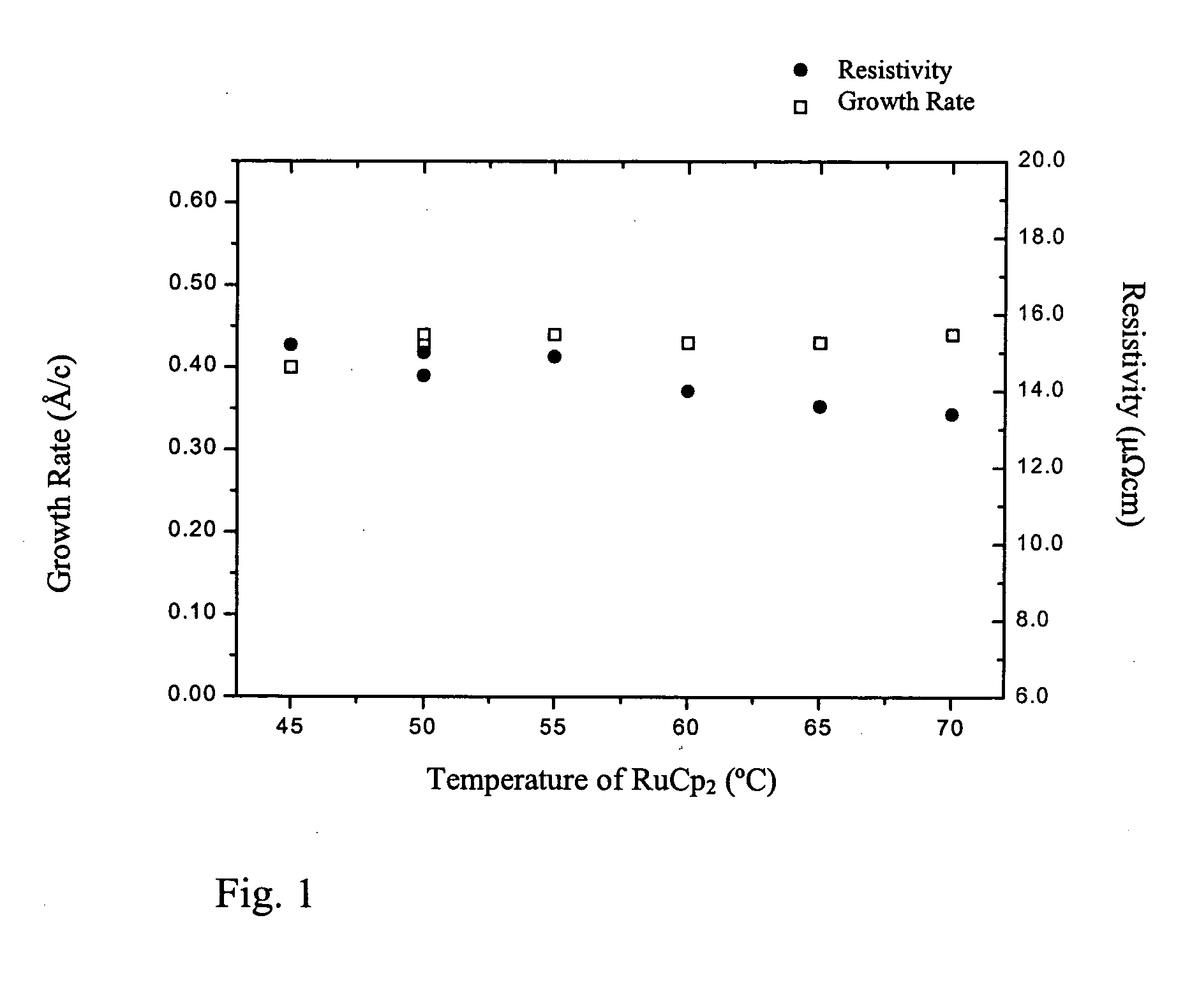Process for producing metal thin films by ALD
a metal thin film and process technology, applied in the field of noble metal manufacturing methods, can solve the problems of difficult patterning platinum layers, poor adhesion of copper to diffusion barrier, easy oxidation, etc., and achieve the effect of improving uniformity of films and reproducibility of processes, promoting nucleation, and facilitating oxidation
- Summary
- Abstract
- Description
- Claims
- Application Information
AI Technical Summary
Benefits of technology
Problems solved by technology
Method used
Image
Examples
example 1
[0073] Ruthenium thin films were deposited in a flow type F-120 ALD reactor (ASM Microchemistry). Bis(cyclopentadienyl)ruthenium (Ru(Cp)2) and air (with a flow rate of 8 sccm during the pulses) were used as precursors. The ruthenium films were deposited on 5×5 cm2 borosilicate glass substrates covered by thin Al2O3 film. The growth temperature was 350° C.
[0074] The Al2O3 film was found to be beneficial to obtain uniform ruthenium films and a reproducible process. The inventors assume that this is due to a high density of reactive sites, such as hydroxyl groups (—OH), on an Al2O3 film. The density of such reactive sites is high on a fresh surface of an Al2O3 thin film that is deposited by ALD. In this experiment the thin Al2O3 film for initiating proper growth of Ru films was produced by ALD by using AlCl3 and H2O or H2O2 as precursors. Total amount of 40 cycles of Al2O3 was applied.
[0075] The effect of the dose of ruthenium precursor was varied by varying the evaporation temperatu...
example 2
[0077] Ruthenium thin films were deposited in a flow type F-120 ALD reactor (ASM Microchemistry). Bis(cyclopentadienyl)ruthenium (Ru(Cp)2) and air (with a flow rate of 8 seem during the pulses) were used as precursors. Ru(Cp)2 was evaporated from an open boat inside the reactor at 50° C. The ruthenium films were deposited on 5×5 cm2 borosilicate glass substrates covered by thin Al2O3 film. The growth temperature was 350° C.
[0078] The effect of the dose of ruthenium precursor was varied by varying the pulse length of the evaporated precursor from 0.2 seconds to 1.2 seconds. The growth rate and the quality of the films were investigated.
[0079] The purge after the ruthenium pulse was 0.5 seconds. The pulse length of air pulse was 0.2 seconds and the purge thereafter was 0.5 seconds. The total amount of cycles was 3000.
[0080] The results in Table 1 show that the deposition rate is independent of the RuCp2 dose as varied through its pulse length, when the pulse time is longer than 0.2 ...
example 3
[0081] Ruthenium thin films were deposited in a flow type F-120 ALD reactor (ASM Microchemistry). Bis(cyclopentadienyl)ruthenium (Ru(Cp)z) and air were used as precursors. Ru(Cp)2 was evaporated from an open boat inside the reactor at 50° C. The ruthenium films were deposited on 5 cm×5 cm borosilicate glass substrates covered by thin Al2O3 film. The tested growth temperature was 350° C.
[0082] The pulse length of evaporated ruthenium precursor was 0.5 seconds and the purge thereafter was 0.5 seconds. The pulse length of air pulse was 0.2 seconds and the purge thereafter was 0.5 seconds. The total amount of cycles was 2000.
[0083] The effect of the dose of oxygen was tested by varying the air flow rate from 0 to 14 sccm. The growth rate and the quality of the films were investigated. The results in Table 2 show that the deposition rate is independent of the air flow above 4 sccm. This proves that the film growth proceeds in a self-limiting manner as characteristic to ALD. Further, as...
PUM
| Property | Measurement | Unit |
|---|---|---|
| thickness | aaaaa | aaaaa |
| thickness | aaaaa | aaaaa |
| thickness | aaaaa | aaaaa |
Abstract
Description
Claims
Application Information
 Login to View More
Login to View More - R&D
- Intellectual Property
- Life Sciences
- Materials
- Tech Scout
- Unparalleled Data Quality
- Higher Quality Content
- 60% Fewer Hallucinations
Browse by: Latest US Patents, China's latest patents, Technical Efficacy Thesaurus, Application Domain, Technology Topic, Popular Technical Reports.
© 2025 PatSnap. All rights reserved.Legal|Privacy policy|Modern Slavery Act Transparency Statement|Sitemap|About US| Contact US: help@patsnap.com



